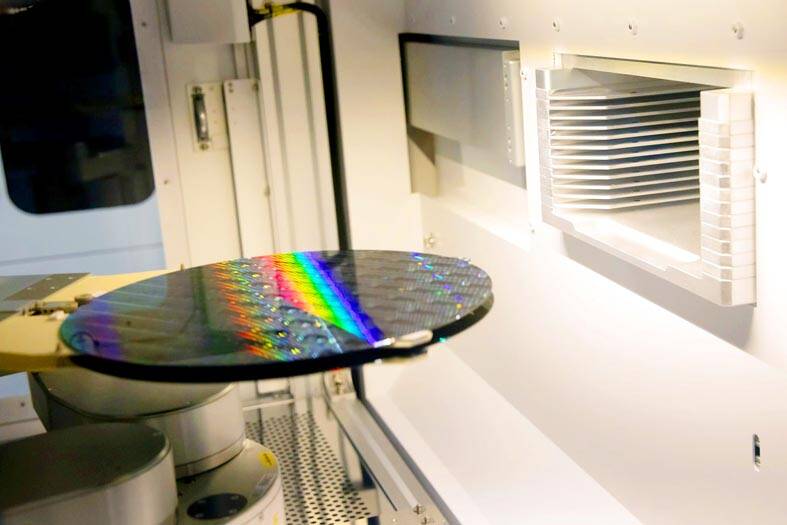The US is to send officials in charge of chip development to Taiwan, Japan and South Korea to promote cooperation in the global semiconductor supply chain, the US Department of Commerce said on Tuesday.
Chips Program Office Director Michael Schmidt announced the visit, which marks the first time officials from the office are to visit the three nations since it was set up in September last year.
“As semiconductors and technologies continue to evolve, the United States will keep working with allies and partners to develop coordinated strategies to ensure that malign actors cannot use the latest technologies to undermine our collective economic and national security,” Schmidt said.

Photo: Bloomberg
“In implementing the CHIPS and Science Act, the Department of Commerce is engaged extensively with key partners and allies, including authorities in the Republic of Korea [South Korea], Japan and Taiwan, as well as the Indo-Pacific Economic Framework, the European Union, and the United States Trade and Technology Council and North American Leaders’ Summit,” he said.
While the office did not disclose any details about Schmidt’s trip, a senior official from the department, who asked not to be identified, said the delegation would include Sam Marullo, senior policy adviser to the office, and Frances Chang, who supervises international exchanges in the office.
Asked whether the delegation would meet Taiwan Semiconductor Manufacturing Co (TSMC) executives, the unnamed official said only that the department would release details at an appropriate time.
“We intend to make this a really important part of our discussions with [South] Korea, Japan and Taiwan,” the official said.
According to the CHIPS Act, the US government is to inject US$52.7 billion into the US semiconductor industry to shore up its manufacturing, and research and development strength.
Funding would include US$39 billion in subsidies for companies that build new facilities and expand production capacity in the US.
The department is reportedly planning to take applications in late June from companies eyeing the subsidies.
The department also announced the so-called National Security Guardrails, which are to ban recipients of US government subsidies from investing in most semiconductor manufacturing in foreign adversary countries — China, Russia, Iran and North Korea — for 10 years after the date of being awarded funding.
The measures also aim to limit funding recipients from engaging in joint research or technology licensing efforts with any of the four countries to develop a technology or product that raises national security concerns, it said.
TSMC is building fabs in Arizona that are to make chips using the 4-nanometer and 3-nanometer processes, with mass production scheduled to begin next year and in 2026.
The unnamed department official declined to comment on whether TSMC is seeking subsidies from the US government.
Hsinchu-based GlobalWafers Co has also begun construction of a 12-inch silicon wafer plant in Texas, with the aim of beginning mass production next year.

SHIPS, TRAINS AND AUTOMOBILES: The ministry has announced changes to varied transportation industries taking effect soon, with a number of effects for passengers Beginning next month, the post office is canceling signature upon delivery and written inquiry services for international registered small packets in accordance with the new policy of the Universal Postal Union, the Ministry of Transportation and Communications said yesterday. The new policy does not apply to packets that are to be delivered to China, the ministry said. Senders of international registered small packets would receive a NT$10 rebate on postage if the packets are sent from Jan. 1 to March 31, it added. The ministry said that three other policies are also scheduled to take effect next month. International cruise ship operators

HORROR STORIES: One victim recounted not realizing they had been stabbed and seeing people bleeding, while another recalled breaking down in tears after fleeing A man on Friday died after he tried to fight the knife-wielding suspect who went on a stabbing spree near two of Taipei’s busiest metro stations, Taipei Mayor Chiang Wan-an (蔣萬安) said. The 57-year-old man, identified by his family name, Yu (余), encountered the suspect at Exit M7 of Taipei Main Station and immediately tried to stop him, but was fatally wounded and later died, Chiang said, calling the incident “heartbreaking.” Yu’s family would receive at least NT$5 million (US$158,584) in compensation through the Taipei Rapid Transit Corp’s (TRTC) insurance coverage, he said after convening an emergency security response meeting yesterday morning. National

PLANNED: The suspect visited the crime scene before the killings, seeking information on how to access the roof, and had extensively researched a 2014 stabbing incident The suspect in a stabbing attack that killed three people and injured 11 in Taipei on Friday had planned the assault and set fires at other locations earlier in the day, law enforcement officials said yesterday. National Police Agency (NPA) Director-General Chang Jung-hsin (張榮興) said the suspect, a 27-year-old man named Chang Wen (張文), began the attacks at 3:40pm, first setting off smoke bombs on a road, damaging cars and motorbikes. Earlier, Chang Wen set fire to a rental room where he was staying on Gongyuan Road in Zhongzheng District (中正), Chang Jung-hsin said. The suspect later threw smoke grenades near two exits

The Forestry and Nature Conservation Agency yesterday launched a gift box to market honey “certified by a Formosan black bear” in appreciation of a beekeeper’s amicable interaction with a honey-thieving bear. Beekeeper Chih Ming-chen (池明鎮) in January inspected his bee farm in Hualien County’s Jhuosi Township (卓溪) and found that more than 20 beehives had been destroyed and many hives were eaten, with bear droppings and paw prints near the destroyed hives, the agency said. Chih returned to the farm to move the remaining beehives away that evening when he encountered a Formosan black bear only 20m away, the agency said. The bear